Identification of the changed Business
Book publishing industry is changing the concept of book printing based on the new market demand and the changes in the new business technology market. These changes aim at increasing the profits earned by the company through increased book distribution. It also takes into consideration the fact that the books have copyrights before being released (Bidgoli, 2006).
The CEO of Hastings House Publishing (HHP) Mr. Peter Leers owns one of these book publishing companies. He is looking forward to changing the market plan of his company to reach the set targets and objectives by increasing the books released, which will increase the company profits by introducing the print on demand technology (POD). To achieve this goal, the CEO of HHP company, Mr. Peter Leers has to use the new printing technology that is now available in the market.
This technology has the effect of reducing production costs. This, therefore, ensures that the investment does not consume a lot of money hence the end results will be increased profits which will be enjoyed in the long run (Cross, 1997).
The Business Concept
The mission and the vision
Hastings House Publishing (HHP) has been in the publishing industry for over seventy years (Lou, 2010). During this period, they have been able to offer a wide range of services to its customers which range from the printing of the book, journals, and magazines. They also provide other services such as design, binding, and publishing books. They have therefore been able to publish a lot of literature in different subjects and fields. Their high-quality work over the years has transformed into a successful company with a lot of loyal consumers.
The Mission of HHP is to provide an excellent consumer service based on effectiveness and efficiency. The company, therefore, ensures that they provide their customers with high-quality jobs at an affordable price. At the present moment, there are a lot of technological advancements even in the publishing industry. To meet the increasing needs of its customers, HHP has been using a low-cost print on demand technology that prints documents using digital files (e.g. PDF format).
This work is normally ready for the customer within minutes. The company has also decentralized its operations to maximize its efficiency through publishing and printing of multi-languages books and other publications all around the world. This will increase the sale of books that have been produced using the new technology which the company has adopted.
A lot of money required to release the books after it is printed by book Publications Companies. However, they never come to know it is going to give a good profit or not, sometimes most of these publishers may not be able to get their expenses. To avoid this loss in book publishing, the publishers can audit the current market and try to put the latest technologies in the book production. As well they can reduce production costs.
HHP has therefore adopted a new technology known as Print on Demand which is efficient and cost-effective. This new technology will aim at reducing production costs. A reduction in the cost of production coupled with increased efficiency to meet the high demand of the market will definitely lead to high-profit returns which will be enjoyed by the company (Camilleri, 2011)
The technology used by HHP
HHP has been working on a program to ensure that there is the availability of classics books for its customers. To reduce costs and have high-quality publications, the company has adopted the print-on-demand technology which works together with Booksurge LLC which is an affiliate of Amazon.com. this move will make it easier for customers to search and own classic books.
What is the value proposition of HHP?
By adopting the print on demand technology, Hastings House Publishing (HHP) will be able to attain a high position in publishing in the thus enhancing the leadership position among other publishers. The stakeholders of the company will therefore have more confidence in it as it will among the best companies in the industries. With this confidence, it will attract new shareholders to invest in the company. The existing shareholders will also increase their investments in the company. This will make the company lead to the growth and development of the company. HHP will therefore be able to expand its production and expand its market in a bid to increase its financial returns (Biddle et al., 2003).
The customers & market of HHP and how this will change
Print on demand technology is a cheaper method of printing as compared to other traditional methods that have been previously used (Callahan, 1997). The method is also convenient for small and medium house publishing such as HHP. Since the company will use this technology to market its wide range of product, it will eventually create new markets that will emerge as a result of provision of basic services or secondary assistance to a higher set of service.
The new markets will help to distribute this technology worldwide as a provision of printing services book and packaging design which will result in the availability of special equipment designed and easy access from anywhere and anytime to be use closely to points of sales. This will make the access of printed materials to the customers to be much easier. Customers can also order specific publications at an affordable price.
How HHP makes money today and what the future will be like?
Hastings House Publishing (HHP) makes money from publishing services. It owns over 3,000 titles; a few of which are unspecified to be printed versions at the present. To be sustainable in the future, HHP has incorporated the use of technology to keep up with the changing pace of customers needs and requirements. That is why it has adopted the print on demand technology in its operations so as to minimize costs and at the same time meet the requirements of its customers.
What is the business entities comprising the present business, and how this needs to change in light of the vision?
HHP is entity comprises of a headquarters, sales department, design department and a project department. The company also introduces new partners into the organization either through hiring and recruiting new employees or by outsourcing some of its divisions such as software supplies department. These departments ensure that there is financial and technical stability in the organization which is essential for the sustainability of the firm in the industry both in the short run and long run.
Who should be involved in the implementation of the vision?
The parties that have to be involved in the implementation of the vision of the company are the administration and management, the sales, design and project departments and the stakeholders.
When and where should all the above happen?
For the project to commence according to the plan which includes the foundation of the structure and establishment of entities there should be availability of softwares and workforce. The project will be separated into several phases depending on the work requirements of each entity. This objective has to be accomplished within two years from the date of commencement.
Brief strategic analysis / feasibility study
Hastings House Publishing Size
HHP is a medium sized company that was started by one author to print books which would tell people all around the world more about America. Since then, the company has grown in terms of size and operations. It has a medium number of staff in all its departments who are qualified and competent in their respective fields. The number of publications has also increased over the years which the company has been in operation; hence the need to adopt the print on demand technology to meet the market demand.
Technology
HHP can stand at an advantage from using out source’s technology companies, which provide and offer many services. These services include building, maintain and hosting of websites and portals. They also develop software and programs application. This is essential as print on demand depends on a reliable high technology infrastructure fir effective and efficient performance. The company should therefore have an in-house data center composed of servers, databases, software, computers and IT engineers and technicians.
A high speed broadband and disaster recovery (DR) site should also be in place. Down-time services should never occur under any circumstances as this might affect the business by giving a bad image to its services and operations. Using out sourced qualified IT companies, will save the company from any additional financial cost and time which will be invested in other sectors (Aribarg et al, 2010). Moreover; this strategy will assist HHP to invest in new technology once it is available.
Financial Viability
Introduction of the new POD system in the company should be followed by changes in commercial operations and process that will for instance accept online payments. For efficiency, this change should be synchronized with the companys Enterprise Resource Planning system (ERP) to ensure that their operations are hand in hand.
Product Quality
The product might change depending on the desired quality that needs to be produced. This will depend on the digital format of the original book or publication that needs to printed, the files or formats that need to be converted and lastly, the design of the book. These productions have to be measured and should meet all the standards that are required for printing and publishing. This will ensure that the production is in line with all the legal requirement of the law and abide by the rules and standards have been set (Nicolini, 2000).
Competition
Printing on demand is a relatively new concept. Due to this fact a lot of companies are applying this concept in their production resulting to a lot of competition. These companies compete for financial resources and other factors of production such as land, labor and raw materials. The most important aspect of competition is for customers who offer demand to their services. For HHP to be successful, it has to have services that are of the best quality to meet the requirements of their customers. In doing so it will be able to win customers from rival companies and maintain its old customers. This will ensure that the company earns good profits from the venture (Gitman and Mcdaniels, 2008).
Risk
There are several risks that may are directly or indirectly involved with the new system of printing on demand (POD). Non-availability of books required or service stop response due to technical or systematically problems are some of the problems that might be experienced. In addition, there is also the risk in of the legality of financial relationship contracts between the POD providers and services providers or authors.
Resources and Capabilities
Since the HHP has been in the publishing industry for a long time, it has developed a lot of experiences, capital resources and capabilities. However, human-resources, printing- resources, logistics-resources, IT-resources and capabilities are still required to operate and maintain the new entities such as Dynamic Portal, Product Design Department, and Software Supplier.
Policies and Principles
Customer and stakeholder relationship management policies and principles
The firm will ensure that the requirements and needs of their customers and stakeholders are met. This can be achieved by having staff that are hard working and have good public relation skills. They should also treat customers with a lot of care and respect (Wheelwright, 2001).
Technology Policies and Principles
The firm should ensure that it uses the latest technology that is efficient and effective in printing and publishing. It should ensure that it has up to date software, manpower and skills that are required to meet the present needs of the customers.
Human Resource and Organizational Principles and Policies
HHP should have principles and policies that support the needs of the employees of the firm. It should therefore adopt good leadership and communication models that ensure all information in the organization flows in all directions and that all employees are involved in decision making. This department is responsible for hiring the staff, keeping them in their respective positions and ensuring that their performance is as per the expected standards (Hannagnan, 2007).
Process- and process management policies and principles
To ensure that the organization achieves its vision, it should formulate and implement policies that ensure that the production process is effective and efficient. This will be achieved by producing high quality orders on time while using minimum costs.
Investment / efficiency related policies and principles
The company should have policies which aim at attracting new partners and shareholders to expand its operations and markets. These policies should therefore ensure that the company earns good profits to attract new investors who will increase its share capital (Selwyn, 2006). The company can also expand its operations through mergers and acquisitions (Ritter, 2000).
Product Quality and Policies
The company should have policies that ensure the quality of its publications are as per the companys requirements and that they have met all the needs of the customers. These policies should therefore be in line with the accepted rules and standards of printing and publication.
Risk management, systemic, etc. policies and principles
HHP should have a team which examines the market and trends in which the publishing industry is changing to avoid the risks which may affect the operations in the organization. It should also have a systematic approach on issues by following procedures and guidelines in the process of production.
Action Plan
Basic Model
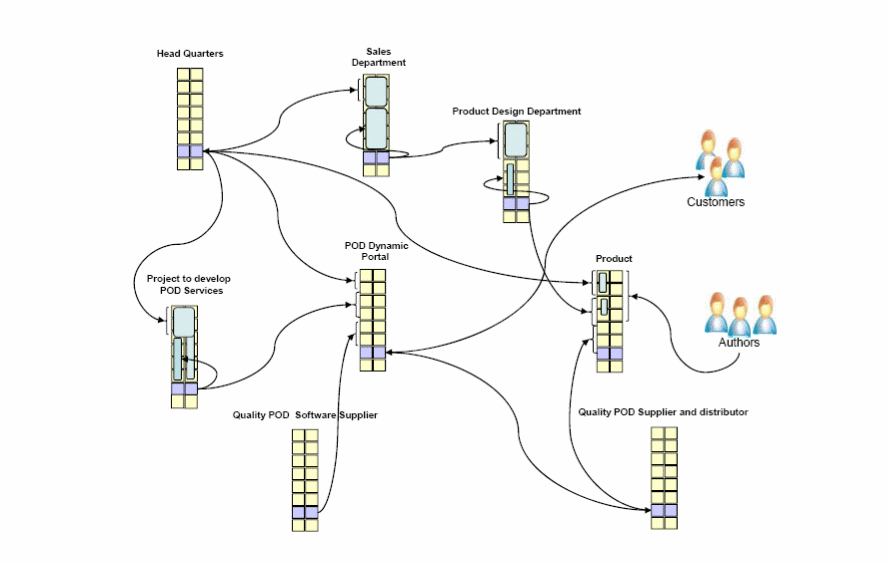
EBE: Headquarters
The headquarters will be responsible for identifying and developing the web portal concept. It will also define the sets of concepts and requirements for the POD project development services. It will be responsible to formulate the rules and regulations that will be involved in the identification of the procedures that will be used in the production of a product. Together with other department, the HQ will be responsible in setting policies and guidelines that will be use to govern the organization at all times. This will ensure that the company attains its targets and objectives.
EBE: POD Dynamic Portal (DP)
The POD Dynamic portal will replace the old way of doing business in HHP. It will be used as the communication interface between the organization and its customers. This new entity will help HHP in exploring modern business methods and reach a wider base of customers.
EBE: Project to develop POD Services
Project to develop POD Services will be responsible on defining the requirements and specification (design, set parameters, type of platform) for the Dynamic Portal (DP) entity.
EBE: Sales Department (SD)
The Sales Department (SD) will be responsible for handling the HHP mission (i.e. increase profits), accomplish to its main goal, and ensure effective and efficient execution of its primary sales and sales management policies and strategies.
EBE: Product Design Department (PDP)
The Product Design Department (PDP), will be responsible for creation, design and implementation of the new type of services and update on the current services that are present in the firm.
EBE: Product Department
The Product Department (PD) will be responsible for production of the required products which have been identified by HQ. This department will also interact with the authors to update, follow up and introduce new titles.
EBE: Quality POD Supplier and Distributor (QSSD)
The Quality POD Supplier and Distributor (QSSD) will be responsible for printing and distribution of the products to customers. These include items like books and soft books in PDF formats.
EBE: POD Software Supplier (QSS)
The Quality POD Software Supplier (QSS) will be responsible for the specification and detailed design of the POD Dynamic Portal requirements such as applications, databases, web portal and online services. Furthermore, (QSS) will be expected to provide, maintain, build, operate and support the Dynamic Portal (DP) system in the future.
The IDEF0 Diagrams of Selected Business Process
Integrated Definition of Function Modelling IDEF0 is a system or technique designed to model the decisions, actions, and activities of an enterprise or system. It is one of the most useful tools to approximate and enhance the process potential. Moreover, it is used to examine and following up all the IDEF0 diagrams in terms and related to process of the selected business operations. The following model can be used by HHP to improve its operations.
Top level of IDEF0 diagram for the Hastings House Publishing
Standing at the top level of the IDEF0 diagram is A0 which indicates the look outs and commitments of the model. It determines which actions will be taken in the event of a sale on demand. It shows all the IOCM process inputs, outputs, mechanism, and control. In addition, it shows the distribution of the different elements of the model (Lei Wu et al, 2009). The customer initiates an order for a book or a title from HHP portal. This is the same place where the customer searches for the book and pays for the order. The order is then processed, printed and delivered to the customer. A0 diagram is shown below.
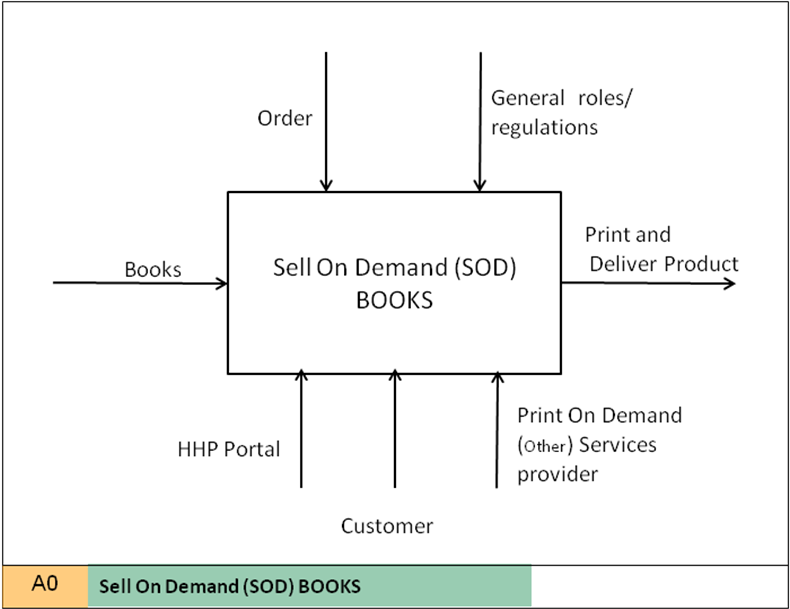
The A0 diagram contains four sub-function divisions which are designated as “Search Book”, “Buy Book”, “Print Book”, and “Deliver Book”. Each sub-function will be modelled separately and will be given a unique number or figure accordingly to a specific order. This will be drawn at the top left side of the diagram. The result after the search turns the input to A2. The payment constrains the order preparation method or process.
This action or activity has to be performed by the company portal which is integrated to the order system. After this, the order will be finalised in the A2 “Buy Book” and processing will begin after which it will be delivered to the customer. The printed order turns the input to A4 which is “Deliver Book”. This is the most important stage in this function since it follows up the order to ensure that it arrives safely to the customer..
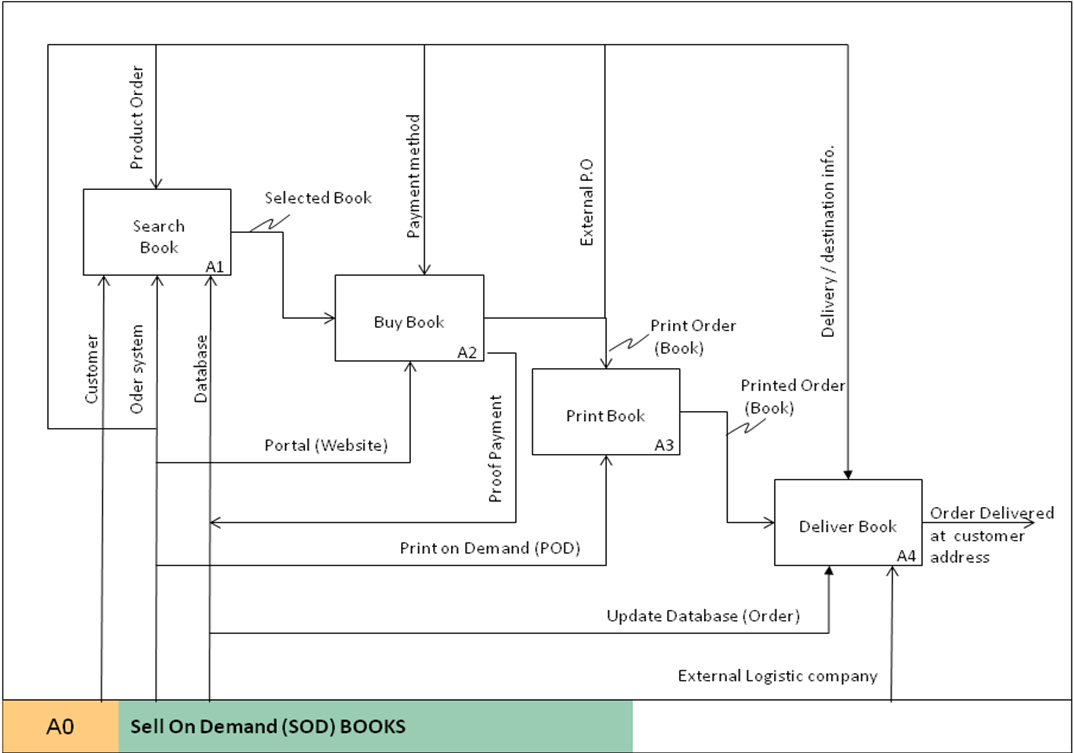
All of these functions and more have been shown in the figure bellow to give better understanding from the processes
A1 diagram of the IDEF0 Model: Search
The level A1of the IDEF0, consists of a function named as “Search Book.” It is divided into three parts: Search for Book, Display Book’s list and Show Book’s Details in the HHP web portal. Customers will be searching for books in the list of book’s and titles before setting up an order. The system retrieves the searching keyword from the portal database and then displays the results according to the customers selection. However, if the selected book is not available, the book availability control condition is triggered sending a message to the HHP portal’s search file as displayed by the customer. This shows the status of the book, whether it is available or not and if need be another search can be conducted again.
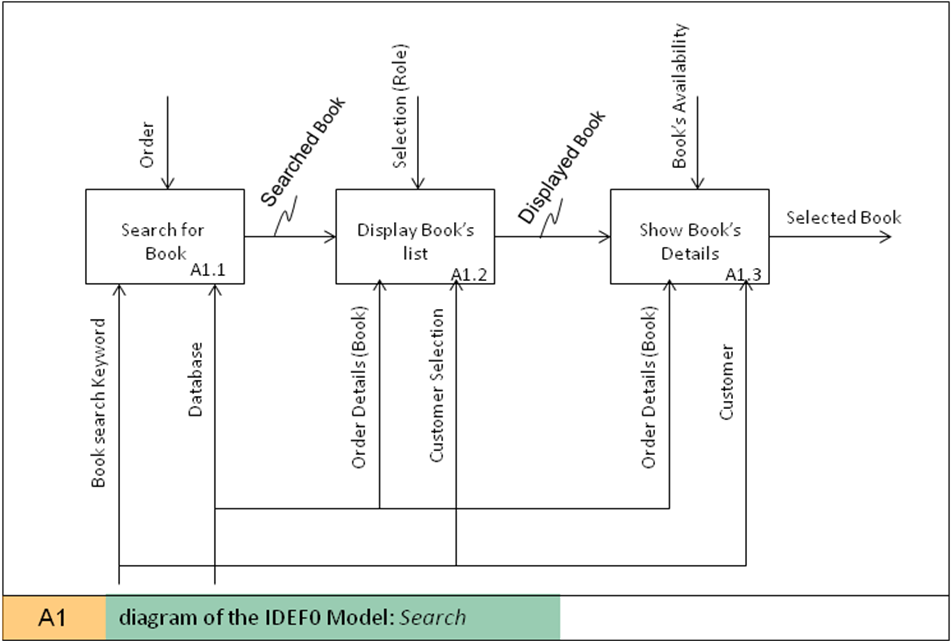
A4 diagram of the IDEF0 Model: Deliver
The level A4 of the IDEF0 consists of a function called “Deliver Book.” It is the final function of sell on demand (SOD) in the IDEF0 model. The generally task of this function is to ensure the delivery of the product. The print order (Book) from the previous function “Print Book” acts as the input. This function has the following two options: deliver the order to the customers address and receiving the proof of delivery.
This method acts as a control tool of the entire process. It considers the type of formats, shape of the book, binding cover and so on. The function may however experience some unexpected problems due to lack of sufficient information. A wrong delivery address, insufficient payment details or location information might cause such discrepancies. To avoid this, HHP uses a subsidiary service known as external logistics which ensures that the order delivery function runs smoothly, effectively and efficiently.
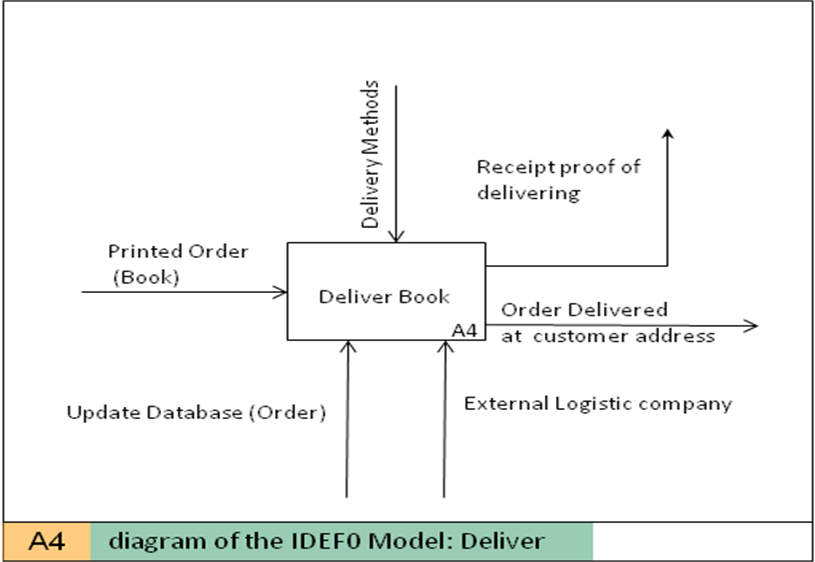
Conclusion
The IDEF0 model clearly describes and demonstrates the policies and procedures of the business model. It can be used as a powerful method for analysing the business as well as providing formal model of the selected business process “Sell On Demand”. With consideration to the selected business, it illustrated the top level of IDEF0 diagram of the business process by clearly stating the sections and subsection of the model and their functions which are expected to be used by HHP in present and future operations.
References
Aribarg , A., Pieters, R. and Wedel, M. (2010) Raising the BAR: Bias Adjustment of Recognition Tests in Advertising. Journal of Marketing Research 3 (47), 30-41.
Biddle, J.E., Davis, J.B. and Samuels, W.J. (2003) Contributions of Medieval Muslim Scholars to the History of Economics and their Impact: A Refutation of the Schumpeterian Great Gap. A Companion to the History of Economic Thought. Malden: Bradshaw.
Bidgoli, H. (2006) Handbook of information security. New York: John Wiley and Sons.
Callahan, M. (1997) From Training to Performance Consulting. Chicago: American Society for Training and Development.
Camilleri, J. (2011) Project Success: Critical Factors and Behaviours. Boston: Gower Publishing.
Cross, R.G. (1997) Revenue management: hard-core tactics for market domination. Washington: Broadway Books.
Gitman, L. and McDaniels C. (2008) The Future of Business: The Essentials. New York: Cengage Learning.
Hannagnan, T. (2007) Management: Concepts and Practices; Financial Times. ND: Prentice Hall.
Lou, Y. (2010) Entry and Cooperative Strategies in International Business Expansion. London: Greenwood Publishing Group.
Nicolini, D. (2000) Organizational Learning. Journal of Management Studies, 37 (6), 783-795.
Ogbor, John. (2009). Entrepreneurship in Sub-Saharan Africa: A Strategic Management Perspective. Johannesburg, AuthorHouse.
Ritter, L. S. (2000) Principles of Money, Banking, and Financial Markets. Menlo Park: Addison-Wesley.
Selwyn, N. (2006) Selwyn’s Law of Employment. Oxford: Oxford University Press.
Ward, K., Kakabadse, A. and Bowman, C. (2005). Designing World Class Corporate Strategies: Value-Creating Roles for Corporate Centres. Manhattan, Butterworth-Heinemann.
Wit, B and Meyer, R. (2010) Strategy: Process, Content, Context, An International Perspective. New York: Cengage Learning EMEA.
Wheelwright, S.C., (2001) Restoring Our Competitive Edge: Competing Through Manufacturing. Wiley, New York.